|
Chorale Melodies used in Bach's Vocal Works
Wer nur den lieben Gott läßt walten |
|
Melody & Text | Use of the CM by Bach | Use of the CM by other composers |
| |
|
Melody & Text: Zahn: 2778 | EKG: 298 |
|
Georg Neumark (1621-1681) documented first printing in “Fortgepflantzter Musikalisch-Poetischer Lustwald,” [Jena, 1657], but the origin of the text and melody can be traced back to Kiel in 1641. There is a very interesting story concerning the background to this particular chorale melody (and text).
Unfortunately, this article on Neumark’s life excludes any mention of his musical abilities as a musician and composer: 1. he played the viola da gamba excellently; 2. as a composer he was influenced by the works of Heinrich Albert. 3. he composed additional ritornelli for his songs, often scored for two violins and bc., but also choral works with instrumental introductions and ritornelli; 4. he composed dance mvts. with Polish-type dance rhythms changing from 4/4 in the ‘Vortanz’ to triple time in the ‘Nachtanz.’
In the 19th century, Johannes Zahn collected 10 different chorale melodies that can be attributed to Georg Neumark. Two of these, the present one and another entitled “Ich lasse Gott in allem walten,” are considered to be of the highest quality in text and music and can easily be compared to the best efforts by Paul Gerhardt and Paul Flemming.
It would appear from the MGGI’s description of Neumark’s song collection from 1657, that the songs included instrumental ritornelli. It would be interesting to see and/or hear Neumark’s own ritornelli associated with his own famous chorale melody. |
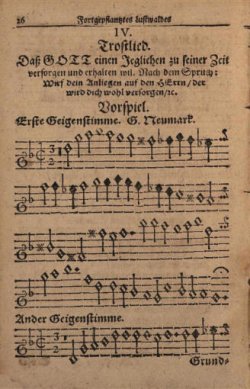
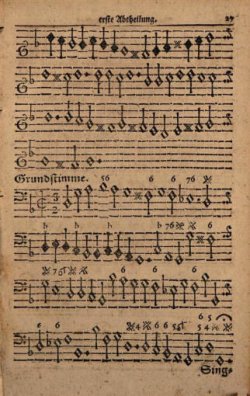

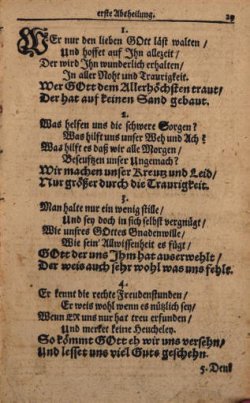
 |
| Dick Wursten kindly contributed
these images as an answer to the wish expressed above.(February 2013) |
| |
|
Chorale Melody Sources: |
|
The Original Source:
It is unclear what the original combination of melody and text from Kiel, 1641, looked like. Very likely it did not include a figured bc and/or instrumental parts. Perhaps it was in the form of an “Einzelblatt” [“broadsheet/broadside”] with only the melody and text.
The Jena, 1657 Source:
The following representations of this source claim to be true to the original.
This source is marked simply “Neumark, 1657” with the original words for the 1st verse underneath: |
|
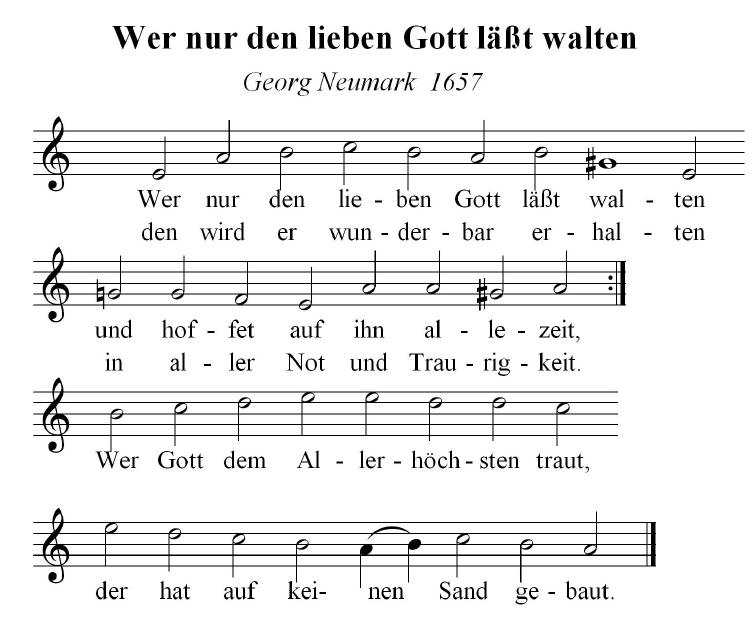
|
|
This is the same in a long line format: |
|

|
|
The EKG presently still has the following version which is claimed to be in the original form (but may have been tampered with): |
|

|
|
From Hymnals Bach May Have Used:
An important hymnal that contained both melodies and parts along with the chorale texts is the “Vopelius” Leipzig, 1682 edition. In this hymnal the melody appears as follows: |
|

|
|
Another hymnal that Bach probably had used is the “Weißenfels, 1714” edition in which the melody appears with a 3/2 time signature: |
|

|
| |
|
Text 1 : Wer nur den lieben Gott läßt walten by Georg Neumark | EKG: 298 |
|
Georg Neumark (1621-1681), who later in life was crowned as poet and held the position of court poet in Weimar, had composed the words and music to this famous chorale after having been attacked and robbed of everything that he possessed while traveling to the University of Königsberg (Kalinengrad) and, in the aftermath of this event, experiencing a difficult winter of deprivation until he finally found a position as a private tutor in Kiel at the end of December of 1641. |
| |
|
Text 2: Wer weiß, wie nahe mir mein Ende by Ämilie Juliane von Schwarzburg-Rudolstadt |
|
Ämilie Juliane von Schwarzburg-Rudolstadt (1637-1706), by birth a countess who was born with the title Countess of Barby in 1637 as a refugee in the fortress Heidecksburg near Rudolstadt and died as Countess von Schwarzburg-Rudolstadt in 1706. She is considered a forerunner of Pietism and wrote a number of chorale texts. This one is from 1686. The present EKG contains this chorale text with a different melody, but with the option that it might be sung to the melody of “Wer nur den lieben Gott läßt walten.” |
| |
|
Text 3 : Ich armer Mensch, ich armer Sünder by Christoph Tietze (1663) |
|
Text contained in the following hymnals that Bach may have had access to:
Wagner (1697), St. Georg (1721, 1730), Vopelius (1729/30, 1737), Dresden (1725, 1728, 1738). However, it was not present as yet in the extensive hymnal with music known as the Vopelius (1682.) |
| |
|
Use of the Chorale Melody by Bach: |
|
Text 1 : Wer nur den lieben Gott läßt walten | EKG: 298
Author: Georg Neumark (1641) |
|
Ver |
Work |
Mvt. |
Year |
Br |
RE |
KE |
Di |
BC |
Score |
Music Examples |
|
2&5 |
BWV 21 |
Mvt. 9 |
1714 |
- |
- |
- |
- |
A99:9 |
|
Mvt. 9 (Leusink) [ram] |
|
7 |
BWV 88 |
Mvt. 7 |
1726 |
104 |
368 |
104 |
- |
A105:7 |
PDF |
Mvt. 7 (MG) [midi] | Mvt. 7 (Leusink) [ram] |
|
1 |
BWV 93 |
Mvt. 1 |
1724 |
- |
- |
- |
- |
A104:1 |
|
Mvt. 1 (Leusink) [ram] |
|
2 |
BWV 93 |
Mvt. 2 |
1724 |
- |
- |
- |
- |
A104:2 |
|
Mvt. 2 (Leusink) [ram] |
|
3~ |
BWV 93 |
Mvt. 3 |
1724 |
- |
- |
- |
- |
A104:3 |
|
Mvt. 3 (Leusink) [ram] |
|
5 |
BWV 93 |
Mvt. 5 |
1724 |
- |
- |
- |
- |
A104:5 |
|
Mvt. 5 (Leusink) [ram] |
|
6~ |
BWV 93 |
Mvt. 6 |
1724 |
- |
- |
- |
- |
A104:6 |
|
Mvt. 6 (Leusink) [ram] |
|
7 & final |
BWV 93 |
Mvt. 7 |
1724 |
- |
369 |
- |
- |
A104:7 |
PDF |
Mvt. 7 (MG) [midi] | Mvt. 7 (Leusink) [ram] |
|
7 or last |
BWV 197 |
Mvt. 10 |
1736-37 |
66 |
370 |
62 |
- |
B16:10 |
PDF |
Mvt. 10 (MG) [midi] | Mvt. 10 (Leusink) [ram] |
|
BWV 197/10: Bach did not indicate which of the 3 chorale texts available to him he wanted with this CM. According to NBA KB the 7th or last verse of Neumark’s hymn is the best possible text to fit the missing text in this wedding cantata. |
|

|
|

|
|
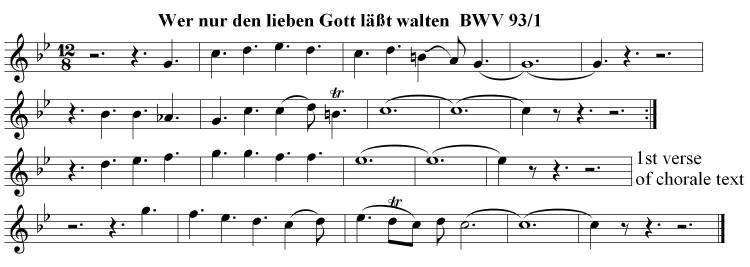

|
|

|
|

|
|

|
|

|
|

|
|

|
| |
|
Text 2: Wer weiß, wie nahe mir mein Ende
Author: Ämilie Juliane von Schwarzburg-Rudolstadt (1686) |
|
Ver |
Work |
Mvt. |
Year |
Br |
RE |
KE |
Di |
BC |
Score |
Music Examples |
|
1 |
BWV 27 |
Mvt. 1 |
1726 |
- |
- |
- |
- |
A138:1 |
|
Mvt. 1 (Leusink) [ram] |
|
12 |
BWV 84 |
Mvt. 5 |
1727 |
112 |
373 |
112 |
30 |
A43:5 |
PDF |
Mvt. 5 (MG) [midi] | Mvt. 5 (Leusink) [ram] |
|
1 |
BWV 166 |
Mvt. 6 |
1724 |
204 |
372 |
204 |
- |
A71:6 |
PDF |
Mvt. 6 (MG) [midi] | Mvt. 6 (Leusink) [ram] |
|

|
|

|
|

|
| |
|
Text 3 : Ich armer Mensch, ich armer Sünder
Author: Christoph Tietze (1663) |
|
Ver |
Work |
Mvt. |
Year |
Br |
RE |
KE |
Di |
BC |
Score |
Music Examples |
|
1 |
BWV 179 |
Mvt. 6 |
1723 |
338 |
371 |
339 |
75 |
A121:6 |
PDF |
Mvt. 6 (MG) [midi] | Mvt. 6 (Leusink) [ram] |
|

|
| |
|
Untexted:
Originally as vocal works or contained in them or supporting them, but appearing as instrumental settings or parts: |
|
Ver |
Work |
Mvt. |
Year |
Br |
RE |
KE |
Di |
BC |
Score |
Music Examples |
|
4 |
BWV 93 |
Mvt. 4 |
1724 |
- |
- |
- |
|
A104:4 |
|
Mvt. 4 (Leusink) [ram] |
|
? |
BWV 434 |
- |
? |
146 |
367 |
146 |
47 |
F205.1 |
PDF |
Chorale (MG) [midi] |
|
- |
BWV 642 |
- |
1714 |
- |
- |
- |
|
K71 |
|
Chorale (MG) [midi] |
|
- |
BWV 647 |
- |
After 1746 |
- |
- |
- |
|
K24 |
|
Chorale (MG) [midi] |
|
? |
BWV 690 |
- |
? |
- |
- |
- |
|
K127 |
|
Chorale (MG) [midi] |
|
- |
BWV 691 |
- |
? |
- |
- |
- |
|
K99 |
|
Chorale (MG) | Chorale (MG) orn [midi] |
|

|
|

|
|

|
|

|
|

|
|

|
|

|
| |
|
Use of the Chorale Melody by other composers: |
|
Johann Samuel Welter (1650-1720):
Cantata Wer nur den lieben Gott läßt walten for C., A., T., B., 2 Violins, 2 Va. da gamba, Violone, Bc-Organo |
|
Georg Böhm (1661-1733):
Wer nur den lieben Gott läßt walten , Chorale Prelude for Keyboard |
|
Georg Friedrich Kauffmann (1679-1735):
A Chorale Prelude for Organ on “Wer nur den lieben Gott läßt walten” in 3 sections with two marked “Alio modo” contained in “Harmonische Seelenlust” [Leipzig, 1733]. See: Score Sample from Part 3 |
|

|
|
Georg Philipp Telemann (1681-1767):
Cantata Wer nur den lieben Gott läßt walten (1722) |
|
Johann Gottfried Walther (1684-1748):
Wer nur den lieben Gott läßt walten a Chorale Prelude for Organ |
|

|
|
Gottfried Kirchhoff (1685-1746):
Wer nur den lieben Gott läßt walten, Chorale Prelude for Organ (with the cantus firmus appearing unembellished in the pedal in the style of Johann Pachelbel.) |
|
Johann Peter Kellner (or Keller) (1705-1772):
Wer nur den lieben Gott läßt walten, Chorale Prelude for Organ |
|
Johann Ludwig Krebs (1713-1780):
Wer nur den lieben Gott läßt walten, Chorale Prelude for Organ |
|
Gottfried August Homilius (1714-1785):
Wer nur den lieben Gott läßt walten, Chorale Prelude for Organ |
|
Johann Philipp Kirnberger (1721-1783):
Wer nur den lieben Gott läßt walten , Chorale Prelude for Organ |
|

|
|
Johann Balthasar Kehl (1725-1778):
Wer nur den lieben Gott läßt walten, Chorale Prelude for Organ, contained in Erste, Zweyte, Dritte, Vierte Sammlung einiger variirender Choräle [Nürnberg, 1764] |
|
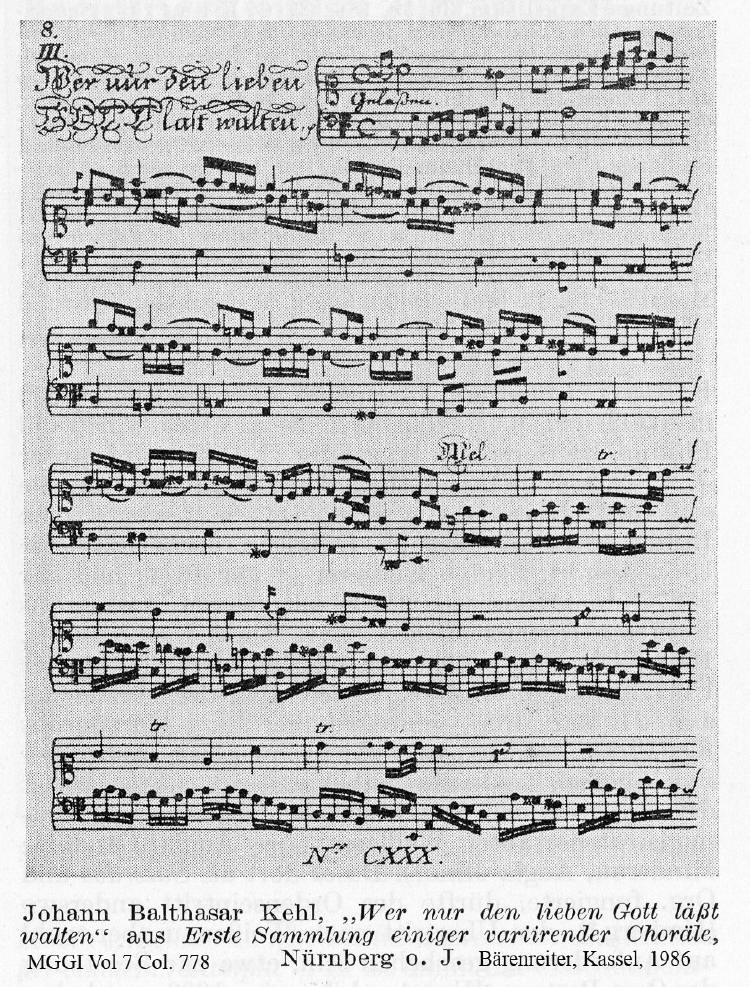
|
|
Michael Haydn (1737-1806):
Wer nur den lieben Gott läßt walten for 2 Sopranos and Orchestra(?) (c1795) |
|
Franz Anton Rösler (also known as Francesco Antonio Rosetti) (1750-1792):
Chorale Setting of Wer nur den lieben Gott läßt (probably for brass instruments) lost |
|
Friedrich Wilhelm Berner (1780-1827):
Chorale Prelude for Organ on Wer nur den lieben Gott läßt walten contained in 8 Choralzwischenspiele |
|
Felix Mendelssohn-Bartholdy (1809-1847):
Wer nur den lieben Gott läßt walten, Chorale Cantata for Solo Voice, Chorus, Strings and Continuo (1829) |
|
Franz Liszt (1811-1886):
Wer nur den lieben Gott läßt walten Nr. 11 of the Zwölf alte deutsche geistliche Weisen (1878-1879) for Piano. |
|
Gottfred Matthison-Hansen (1832-1909):
Wer nur den lieben Gott läßt walten, Paraphrase for Organ op. 37 |
|
Friedrich Wilhelm Franke (1862-1932):
Chorale Variations on Wer nur den lieben Gott läßt walten |
|
Georg Schumann (1866-1952):
Variations on Wer nur den lieben Gott läßt walten for Organ and Orchestra, Op. 24 |
|
Curt Doebler (1896-1970):
Wer nur den lieben Gott läßt walten, Cantata for mixed choir a cappella |
|
Alfred von Beckerath (1901-1978):
Chorale Fantasia on Wer nur den lieben Gott läßt walten for Organ |
|
Willy Burkhard (1900-1955):
Wer nur den lieben Gott läßt walten, Partita for Organ (1932) |
|
Ernst Pepping (1901-1981):
Wer nur den lieben Gott läßt walten, Partita for Organ (1932) |
| |
|
Sources: NBA, vols. III/2.1 & 2.2 in particular [Bärenreiter, 1954 to present] and the BWV ("Bach Werke Verzeichnis") [Breitkopf & Härtel, 1998]
The PDF files of the Chorales were contributed by Margaret Greentree J.S. Bach Chorales
Software: Capella 2004 Software, version 5.1.
Prepared by Thomas Braatz & Aryeh Oron (September 2005 - May 2009)
Thanks to contributors: Dick Wursten
(February 2013) |